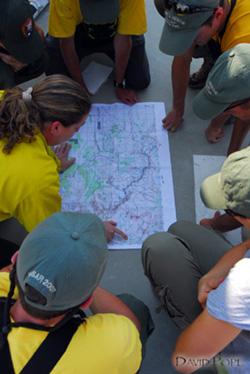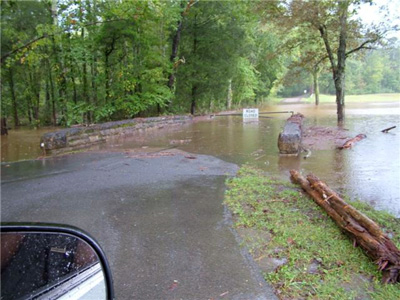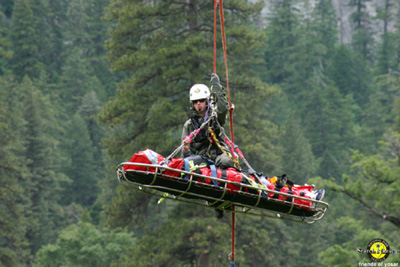
Parks prepared for natural disasters
America’s national parks cannot prevent Mother Nature from her wrath, but preparation, planning, and help from federal, state and local governments can minimize the peril and damage.
When a disaster occurs, managers of public places such as national parks must be ready to respond. Each national park must deal with natural disasters such as floods, fires, earthquakes, avalanches, and severe storms as much as possible using its own resources in combination with supporting local government agencies.
Local agreements with fire, emergency response teams, and police departments are made for each facility within the National Park Service.
| Click on the video at right to see a slide show about disaster planning in the national parks prepared by writer Erin Simpson (Photos courtesy of the National Park Service). |
Many parks and other NPS units are small and do not possess their own fire trucks or emergency staff. Only the largest parks have such resources. And, of course, some natural disasters require the efforts of many government organizations.
National parks are divided into seven different regions throughout the United States. Each park submits one park ranger’s name every six weeks to a national call-out list. The lists will usually consist of 10 to 15 park rangers per region.
For example, Chickamauga and Chattanooga Battlefield National Military Park in Fort Oglethorpe, Ga., is one site in the southeast regions. It includes Lookout Mountain Battlefield in nearby Chattanooga, Tenn. One of the park rangers from this specific unit will be selected as a member from the national call-out list.
Todd Roeder, chief ranger at Chickamauga Battlefield National Military Park, stated that coordination is required when disaster strikes.
“If a natural disaster occurs, Shenandoah National Park’s dispatch will be notified. The national call-out list will be activated, and every member of the call out list will report to the site of the disaster,” he explained.
If a natural disaster such as a severe storm transpires, the national park will notify the incident commander at the Incident Command Center (ICC). The ICC contains a well-defined and effective procedure for disaster response called the Incident Command System (ICS).
| At right, National Park Service search and rescue teams go over new and improved disaster plans (Photo by David Pope, courtesy of the National Park Service). Next, flooding at Chickamauga and Chattanooga National Military Park required assistance from local agencies to recover from damage (Photo courtesy of the National Park Service). Last, the Yosemite Search and Rescue team is trained for rescues during natural disasters (Photo courtesy of Yosemite National Park Search and Rescue and the National Park Service). |  |
The ICS was created in the 1970s due to the miscommunication and management deficiencies of a wildfire, which resulted in property damage and fatalities.
The ICS is a federal organization that includes policies, procedures, facilities, equipment and a staff that works together to improve the effectiveness of emergency response.
Agencies involved in the ICS are the National Guard, U.S. Army and the Emergency Medical Team (EMT).
ICS’s response to national parks is determined by priority based on a natural disaster’s damage.
Yosemite National Park is one of the largest in the U.S. national parks system and the unit has a large staff that many times can handle situations within the park. The majority of their disasters are rock slides, earthquakes, floods and fires.
Major floods in the valley, for example, would require help from supporting local Northern California governments as well as state and federal agencies.
For every emergency, parks contact the incident commander. These individuals can come from different park divisions. At Yosemite National Park, for example, the incident commander comes from the Protection Division. The Protection Division is made up of law enforcement officers, search and rescue personnel, and firefighters.
 The Emergency Management Assistance Compact (EMAC) is a national organization that supplies structure to interstate mutual aid in an occurrence of a natural disaster.
The Emergency Management Assistance Compact (EMAC) is a national organization that supplies structure to interstate mutual aid in an occurrence of a natural disaster.
A state that suffers from a natural disaster can ask for assistance from another member state.
Smaller national parks tend to heavily rely on local and state agreements with local agencies, when the size of the incident is not significant enough to engage federal resources.
The National Historic Preservation Act (NHPA) of 1966 plays a huge role in which national parks are eligible for federal funds for recovery and restoration after a disaster such as a flood or windstorm. The NHPA contains a National Register list of districts, sites, buildings, structures and objects worthy of preservation. If determined worthy, these sites will be qualified for grants, loans, and tax incentives.
The State Historic Preservation Office (SHPO) is one of the key organizations to provide assistance to national parks. SHPO nominates property to the National Register to maintain a statewide preservation plan.
When a disaster hits, SHPO allocates a certain amount of money in federal funds. The money is determined by the amount of damage to the area. However, the incident must be properly reported in order to receive money.
When damage is too overwhelming for state and local authorities, the Federal Emergency Management Agency (FEMA), a branch of the U.S. Dept. of Homeland Security, will become involved.
If a natural disaster occurs, the governor of that state declares a “state of emergency” and formally requests that FEMA reports to disaster.
FEMA will then request the National Park Service to develop a strategy to identify and evaluate all effected property. FEMA must abide by Section 106 of the National Historic Preservation Act requirements.
Section 106 mandates a review process for all federally funded and permitted projects that will impact sites listed on the National Register of Historic Places.
National parks will do their preparation part by educating people living in and around the national park. This ranges from national parks informing others on how to protect themselves and property if a fire emerges to teaching them what certain plants grow where.
“On a national park level, our job is to educate and teach people how to protect their property and themselves,” Janet Ambrose, superintendent of the Obed National Wild and Scenic River in Tennessee, said,
Another factor that can prevent damages is disaster preparedness. This is the ultimate responsibility of a national park. However, planning for disasters can be time consuming, confusing and even ineffective.
 Luckily, software called “dPlan” has been created in hopes of clarifying the disaster-planning process and assuring their plans are in order.
Luckily, software called “dPlan” has been created in hopes of clarifying the disaster-planning process and assuring their plans are in order.
dPlan is a fill-in-the-blank device that provides a comprehensive disaster plan in hopes of protecting cultural sites. dPlan is based on prevention, preparedness, response and recovery.
When dPlan has been filled out, updating the plan has been made accessible, because effective disaster planning is continuous.
FEMA is doing its best to prepare for disasters as well. Strategies and pre-mitigation programs are strongly encouraged in order to reduce potential damage to national parks.
FEMA’s pre-mitigation program provides funds to states for hazard mitigation planning. Funding these plans and projects overall reduces risks to population and structures while also reducing reliance on funding from other disaster organizations.
National parks must rely on help from federal, state and local agencies. Mother Nature may have ultimate control of the park, but disaster preparedness and government agency aid can lessen damage and ultimately expedite the recovery process.
For More Information:
Chickamauga and Chattanooga National Military Park
P.O. Box 2128
Fort Oglethorpe, GA 30742
706-866-9241
Obed Wild and Scenic River
P.O. Box 429
Wartburg, TN 37887
423-346-6294
Yosemite Public Information Office
P.O. Box 577
Yosemite, CA 95389
209-372-0200

Comments are Closed